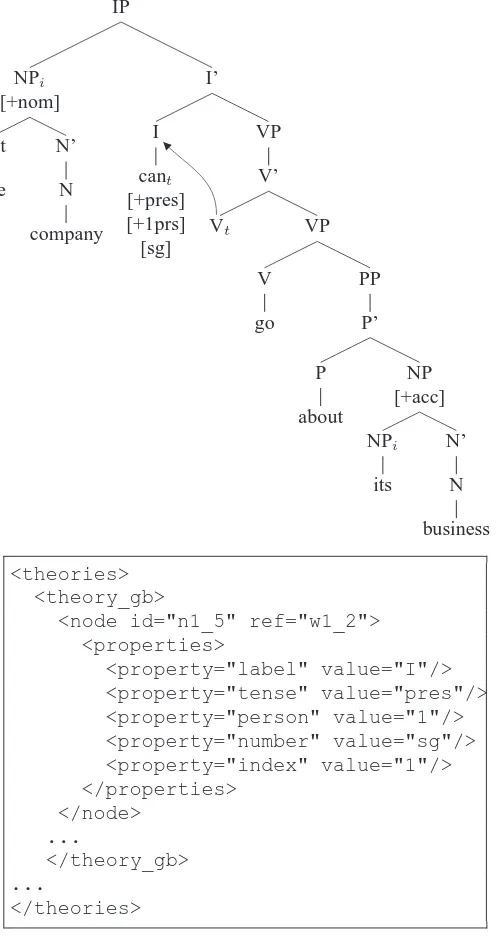Parallel multi-theory annotation of syntactic structure
Jerid Francom and Mans Hulden
The University of Arizona Tucson, AZ 85721
{jeridf,mhulden}@email.arizona.edu
Abstract
We present an approach to creating a treebank of sentences using multiple notations or linguistic theories simultaneously. We illustrate the method by annotating sentences from the Penn Treebank II in three different theories in parallel: the original PTB notation, a Functional Dependency Grammar notation, and a Government and Binding style notation. Sentences annotated with all of these theories are represented in XML as a directed acyclic graph where nodes and edges may carry extra information depending on the theory encoded.
1.
Introduction
Following the establishment of various treebanks for an assortment of languages, the past few years have been marked by strong interest in the development of parallel treebanks—that is, treebanks that simultaneously annotate sentences in two or more languages. For machine transla-tion purposes in particular, this effort seems to prove quite valuable. In contrast to such multi-language annotation work, far less attention has been given to multi-theory anno-tations: annotating treebanks in parallel following different linguistic theories.
The current work highlights limitations in current treebank formulations that potentially restrict the accessibility and overall usefulness of treebanks and suggests that such lim-itations can be reduced by incorporating syntactic annota-tion for a set of sentences in multiple theories. Furthermore, a multi-theory treebank creates a host of novel opportuni-ties that cannot be addressed under current approaches to corpus annotation. Yet the practical problems surround-ing such multi-theory treebanks are quite different in na-ture from those seen in multi-language treebanks. In what follows, we shall present the arguments supporting the cre-ation of a multi-theory treebank, an elaborated review of the properties to consider in annotating sentences in a va-riety of theories simultaneously, provide a set of examples in various theoretical frameworks, and discuss the difficul-ties one faces in the development of such a multi-purpose treebank.
2.
Treebanks and linguistic theory
Treebanks such as the Penn Treebank (Marcus et al., 1994) have become a rich source of data applicable to research in theoretical, corpus and computational linguistics. The syntactic annotation supplied in these sources allows the researcher the ability to extract sub-sentential information from a range of sentence types for a wide variety of appli-cations.However, the current set of treebanks is not without short-comings. First, very few treebanks in wide use today over-lap with respect to the collection of sentences that have been annotated.1The data used in a given treebank may not
be optimal for all types of research due to the nature of the
1The larger richly annotated treebanks available for English
source.2 This, in turn, hinders the potential of any given
treebank to serve as a general-purpose resource. Also, many treebanks either assume a theory-neutral approach to annotation or adopt some very specific theoretical frame-work. In some cases, the lack of detailed theory-specific in-formation has been overcome by adding more refined anno-tations to existing generic treebanks (Honnibal and Curran, 2005; Hockenmaier and Steedman, 2007). Also, particular theoretical questions may not be easily pursued with exist-ing treebanks due to the specific needs of the researcher, despite the attractiveness of the data on other grounds (i.e. text-source, language, size, etc.) Taken together, the overall usefulness of treebanks may not be fully realized under the current formulation.
Our proposal aims to fill this apparent gap and create novel research opportunities by elaborating an encoding scheme for a ‘parallel multi-theory’ treebank—that is, a treebank which simultaneously annotates sentences in two or more theoretical frameworks. With the popularity of multi-language treebanks and the growth of more reliable parsing methods that require less manual intervention than before, the possibility of annotating a single collection of sentences using different theories is becoming feasible with much less effort than in the past.
A multi-theoretical approach to treebanks shows promise in overcoming those aspects of current treebanks that re-strict their overall convenience as a tool for research. This approach creates an alternative to the theory neutral vs. the-ory specific issue of annotation while providing the ability to extrapolate information over the same data set regardless of the researcher’s theoretical flavor of interest.3
Further-more, given explicit correspondences between theoretical machinery, a multi-theory collection also provides a host of other potential applications that benefit from the opportu-nity to ask questions about the data in one theory relative to
such as the Penn treebank (Bies et al., 1995) and LinGO Red-woods (Oepen et al., 2004) all annotate different sets of sentences.
2Treebanks vary on a variety of properties that may render
an particular dataset less-than-optimal, including the text source: newspaper, web, conversation, etc.; language, relative size, etc.
3
A. Mengel and W. Lezius. 2000. An XML-based represen-tation format for syntactically annotated corpora. Pro-ceedings of the Second International Conference on Lan-guage Resources and Engineering (LREC), 1:121–126. S. Oepen, D. Flickinger, K. Toutanova, and C. D.
Man-ning. 2004. LinGO Redwoods. Research on Language & Computation, 2(4):575–596.
Y. Samuelsson and M. Volk. 2005. Presentation and rep-resentation of parallel treebanks. Proc. of the Treebank-Workshop at Nodalida.


